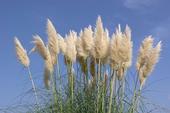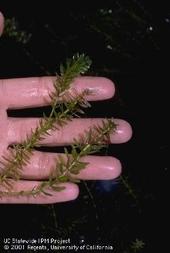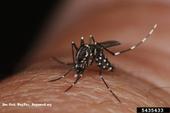- Author: Lauren Fordyce

Pampasgrass (Cortaderia selloana) is a common ornamental landscape plant that readily naturalizes throughout California's coastal areas and some interior regions. Historically, pampasgrass was planted for erosion control, but it has since escaped cultivation and spread along sandy, moist ditch banks throughout coastal regions of southern California. Pampagrass can also grow in the hot, dry climate of inland areas of California.
A similar-looking invasive grass, jubatagrass (Cortaderia jubata), is more widespread, aggressive, and is a major pest in coastal redwood forest areas. Jubatagrass thrives in cool, foggy environments and does not tolerate temperature extremes or...
- Author: Lauren Fordyce

The glassy-winged sharpshooter is a large leafhopper that can transmit several important, often fatal, plant diseases in California. This includes Pierce's disease of grape, alfalfa dwarf, almond leaf scorch, and mulberry leaf scorch. Pierce's disease is of most concern in California since the state accounts for about 94% of U.S. grape production.
Pierce's disease of grape has been reported in many counties throughout California. View a map of the current distribution of the pathogen. Glassy-winged sharpshooter adults...
- Author: Lauren Fordyce

Hydrilla (Hydrilla verticillata) is an invasive, aquatic weed that can be found in many slow-moving fresh water bodies in California. The plant forms large mats that can crowd out native plants, restrict water flow, and interfere with boating and fishing. These mats can reduce habitat for fish and other wildlife, degrade water quality, and increase the risk of flooding.
Hydrilla is easily spread since it often breaks apart into tiny pieces that can each produce new plants. It also produces special survival structures on the stems (turions) and in the sediment (tubers). Each tuber can produce a new plant. The tubers can survive up to seven years in the sediment before sprouting, even if no water is...
- Author: Lauren Fordyce

Aedes mosquitoes can transmit some of the most debilitating and deadly mosquito-borne pathogens to humans, such as Zika virus, dengue virus, chikungunya virus, and yellow fever virus. One Aedes species is also capable of transmitting heartworm to dogs. These invasive mosquitoes are now present in many regions of California, from Shasta County to San Diego County. View a map of Aedes distribution by county.
The yellow fever mosquito (Aedes aegypti), the Asian tiger mosquito (Aedes albopictus), and the Australian backyard mosquito (Aedes notoscriptus) are unlike...
- Author: Lauren Fordyce

Help increase public awareness of invasive species and encourage participation in the ongoing fight against invasive species by celebrating California Invasive Species Action Week (CISAW) June 1- 9, 2024.
Invasive species include non-native plants, animals, and pathogens that can negatively impact our waters, native ecosystems, agriculture, health, and economy. Every day this week, UC IPM will share information spotlighting a different invasive species, its impacts, and what you can do to help.
Keep an eye out for our upcoming blog posts and check out the resources below to learn more about invasive species:
- Read UC IPM's previous blog posts on


